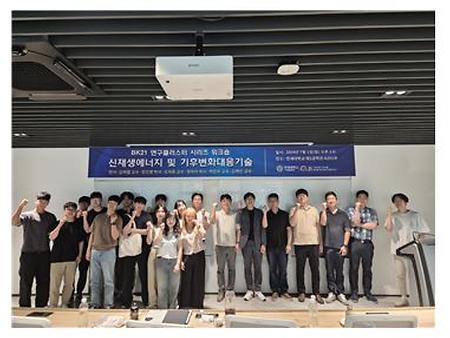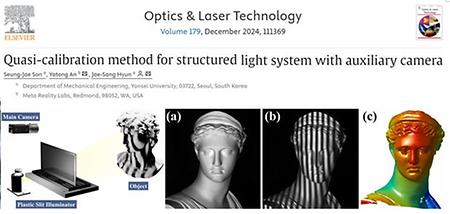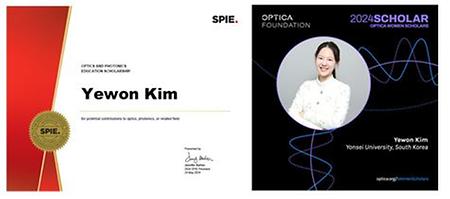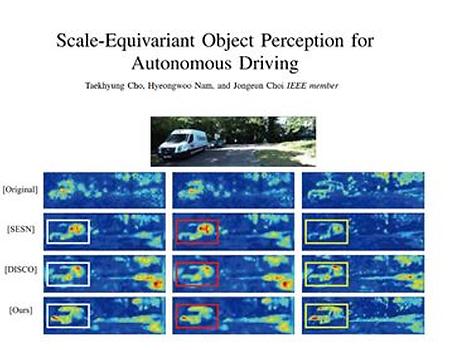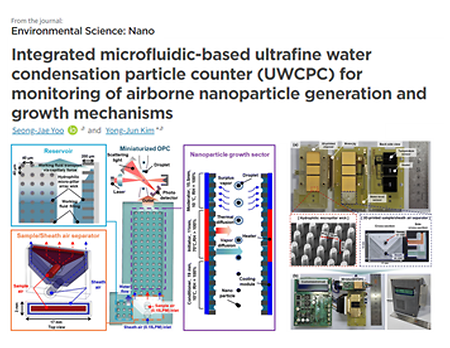-
151
- Symposium on Renewable Energy and Climate Change Mitigation Technologies
- Symposium on Renewable Energy and Climate Change Mitigation Technologies Professor Hae-Jin Kim from the Department of Mechanical Engineering hosted a symposium on renewable energy and climate change mitigation technology on July 1, 2024, at Engineering Hall#1 of Yonsei University. This event was held in collaboration with Dankook University, Dongguk University, Sookmyung Women's University, the Korea Institute of Energy Research (KIER), and the Korea Institute of Science and Technology (KIST). The symposium was part of a series organized by the BK21 project group of the Department of Mechanical Engineering at Yonsei University, aimed at sharing ongoing experimental results and discussing research trends in renewable energy and climate change mitigation technology with approximately 30 participants. The event featured six main topics including ▲Photoelectrochemical energy devices using QD photosensitisers, ▲Flexible Perovskite/CIGS Tandem Solar Cells, ▲Interactive materials for engineering interfaces in optoelectronics, ▲Development of materials for perovskite solar cells with high thermal stability,▲ Multiscale perovskite/polymer nanocomposites synthesized via coordination chemistry for optoelectronics, ▲Soft Electronics and Beyond.
- 기계공학부 2024.07.18
-
150
- Dr. Lee appointed as Tenure-track Assistant Professor at St.Thomas University
- Dr. Lee appointed as Tenure-track Assistant Professor at St.Thomas University After completing his doctoral degree in the laboratory of Professor WonHyoung Ryu in August 2020, and working as a postdoctoral researcher at BK21 in Mechanical Engineering, Dr. Jiyong Lee, who is currently working as a researcher at the University of Minnesota, will be appointed to the University of St. Thomas, as an tenure-track assistant professor in the Department of Mechanical Engineering. While working as a post-researcher at the BK Project Group, Dr. Lee published numerous top-level SCI papers in Adv. healthc. Mater., Adv. mating. Technol., J. Control, Small, etc.
- 기계공학부 2024.07.18
-
149
- Quasi-calibration method for structured light system with auxiliary camera
- Quasi-calibration method for structured light system with auxiliary camera The research team led by Professor Jae-Sang Hyun from the Department of Mechanical Engineering (with first author Seung-Jae Son, integrated course) conducted joint research with Meta Reality Labs and has developed a '3D camera calibration method using an auxiliary camera.' This research simplifies the relatively complex projector calibration process by using an auxiliary camera and enables 3D shape reconstruction with higher measurement accuracy than existing methods. The research has been published in the renowned international academic journal 'Optics and Laser Technology' in June 2024. The link: https://doi.org/10.1016/j.optlastec.2024.111369
- 기계공학부 2024.07.18
-
148
- Identifying the thermal decomposition mechanism of solid electrolyte interphase that cause thermal runaway in electric v
- Identifying the thermal decomposition mechanism of solid electrolyte interphase that cause thermal runaway in electric vehicles The research team of Prof. Jongsup Hong of the Department of Mechanical Engineering collaborated with the research team of Prof. Kyunghak Kim of Hanyang University to identify the thermal decomposition mechanism of solid electrolyte interphase on the anode, which is a major cause of thermal stability and fire safety degradation in electric vehicles. The team focused on the thermal decomposition reaction of the solid electrolyte interphase that occurs in the early stages of thermal runaway and impairs the fire safety of electric vehicle batteries. Based on in-situ infrared spectroscopy-based spectral experimental measurements and density functional theory-based simulations, the researchers identified the decomposition mechanism of the solid electrolyte interphase at the atomic scale. This research provides key insights for improving fire safety in thermal runaway of electric vehicles, and the work was published in Energy Storage Materials, a top journal in the field of energy and materials (impact factor: 20.4 in 2022, JCR: 4.2% in Materials science, multidisciplinary), which recognized the qualitative excellence of the work. The link: https://doi.org/10.1016/j.ensm.2024.103517
- 기계공학부 2024.07.16
-
147
- Yewon Kim, 2024 Scholarship Recipient of Optica Women Scholars and SPIE Optics and Photonics Education Scholarship
- Yewon Kim, 2024 Scholarship Recipient of Optica Women Scholars and SPIE Optics and Photonics Education Scholarship This scholarship is awarded annually by OPTICA, one of the largest academic societies in the field of optics, to 20 female students worldwide who are recognized for their potential leadership in the field. Yewon Kim from Yonsei University was the first recipient from South Korea. Additionally, in May, Yewon Kim was selected as a recipient of the '2024 Optics and Photonics Education Scholarship' awarded by SPIE (the International Society for Optics and Photonics). This scholarship is awarded annually by SPIE, the largest academic society in the field of optical engineering, to students who are expected to make significant contributions to the field. Three students from South Korea, including Yewon Kim from Yonsei University, were selected this year. Yewon Kim has been focusing on developing deep-learning based self-calibrated lens-less microscopy technology. She is also conducting various research projects in the field of computational imaging, including imaging multi-layered semiconductors.
- 기계공학부 2024.07.16
-
146
- Scale-Equivariant Object Perception for Autonomous Driving
- Scale-Equivariant Object Perception for Autonomous Driving The MLCS research team from the School of Mechanical Engineering, led by Professor Jongeun Choi (co-first authors of this study are Taekhyung Cho and Hyeongwoo Nam), has developed an object detection model using scale-equivariant CNN models to enhance object recognition technology used in autonomous driving. To address the vulnerabilities of traditional CNN models to image rotations, reflections, and scale transformations, a scale-equivariant feature extraction backbone network is developed. When validated on the KITTI dataset, the model demonstrated superior object detection performance compared to other methods. The research findings were published in the renowned international journal 'IEEE Transactions on Intelligent Vehicles' (Impact Factor: 14.0, Ranks in the top 1.3%) in March 2024. The link: https://ieeexplore.ieee.org/abstract/document/10480255
- 기계공학부 2024.07.16
-
145
- Vision-Based Robotic Manipulation through SE(3)-Equivariant Diffusion Models (2024.02.27)
- Vision-Based Robotic Manipulation through SE(3)-Equivariant Diffusion Models The MLCS research team from the Department of Mechanical Engineering, led by Professor Jongeun Choi (first author: Master's student Hyunwoo Yoo), presented the world's first vision-based SE(3)-Equivariant Diffusion Models for robotic manipulation at the 2024 “IEEE/CVF Conference on Computer Vision and Pattern Recognition (CVPR),” the top international computer vision conference in the AI field (h5-index: 422). This study is a follow-up to the “Equivariant Descriptor Fields (EDFs)” research presented at the 2023 “International Conference on Learning Representations (ICLR),” the top international machine learning conference (h5-index: 303). To advance the diffusion model version of the previous research, new theories were established. By utilizing SE(3)-Equivariance, the model robustly handles previously unseen orientations of target objects, making it a data-efficient robotic learning model that does not require learning for every possible scenarios. While typical visual robot learning models require hundreds or thousands of hard-to-obtain expert training data points, this study achieves effective learning with only 5-10 data points. Additionally, unlike existing studies, this approach enables end-to-end learning that anyone can easily perform. Recognized for its excellence, this research was selected as a Highlight paper (top 2.8% of all submitted papers, top 11.9% of published papers) at the 2024 “IEEE/CVF Conference on Computer Vision and Pattern Recognition (CVPR).” The link: https://openaccess.thecvf.com/content/CVPR2024/html/Ryu_Diffusion-EDFs_Bi-equivariant_Denoising_Generative_Modeling_on_SE3_for_Visual_Robotic_CVPR_2024_paper.html
- 기계공학부 2024.07.16
-
144
- Mechanical Activation of Graphite for Na-Ion Battery Anodes: Unexpected Reversible Reaction on Solid Electrolyte Interph
- Mechanical Activation of Graphite for Na-Ion Battery Anodes: Unexpected Reversible Reaction on Solid Electrolyte Interphase via X-Ray Analysis The research team led by Professor Seong Chan Jun of the Department of Mechanical Engineering (First author of this study are Su Chan Lee) and Dr. Chung KIST's team conducted a joint study under the theme of 'Mechanical Activation of Graphite for Na-Ion Battery Anodes: Unexpected Reversible Reaction on Solid Electrolyte Interphase via X-Ray Analysis'. In this paper, the sodium ion storage capacity of graphite was greatly improved through mechanical activation. The research team produced graphite with a defective structure using a ball milling technique, and analyzed its electrochemical performance using it as an SIB cathode. As a result, the activated graphite exhibited a sodium ion storage mechanism distinct from that of hard carbon. In the activated graphite, simultaneous reactions occurred at both the surface and bulk levels, with reversible reactions of Na2CO3 and NaF occurring on the SEI surface. This process enhanced the sodium storage performance by acting as an auxiliary sodium reservoir on the defect-rich carbon surface. The study demonstrated that the defect-rich carbon electrodes offer a new reaction mechanism characterized by unexpected reversible reactions on the SEI surface. This study was published in the world-renowned international journal 'Advanced Science' (Impact Factor: 15.1). The link: https://doi.org/10.1002/advs.202401022
- 기계공학부 2024.05.22
-
143
- Professor Jongbaeg Kim's Appointment as the 2023 Hwalchun Distinguished Professor of the Yonsei University College of En
- Professor Jongbaeg Kim's Appointment as the 2023 Hwalchun Distinguished Professor of the Yonsei University College of Engineering Professor Jongbaeg Kim from the department of mechanical Engineering has been appointed as the 2023 Hwalchun distinguished professor of Yonsei university college of engineering. This honor is awarded based on evaluations of publications in international journals, research impact, research funding achievements, as well as contributions to education and service. The Hwalchun distinguished professor program provides benefits including financial incentives to researchers who have made substantial research and service contributions to the college ofengineering at Yonsei university. For the year 2023, a total of two professors from the college of engineering have been selected for the Hwalchun distinguished professor
- 기계공학부 2024.05.22
-
142
- Development of integrated microfluidic-based ultrafine water condensation particle counter (UWCPC) for monitoring of air
- Development of integrated microfluidic-based ultrafine water condensation particle counter (UWCPC) for monitoring of airborne nanoparticle generation and growth mechanisms Research team led by Professor Yongjun Kim of the Department of Mechanical Engineering and the first author, Dr. Seongjae Yoo introduced a microfluidic-based ultra-fine water condensation particle counter (UWCPC) made with PCB and 3D printing technology. UWCPC is a low-cost, miniaturized microfluidic device for monitoring nanoparticle generation and growth mechanisms in atmosphere. This device consists of a sheath/sample air separation unit, a nanoparticle growth section, and a small optical particle counter, and is capable of measuring particles down to 3.4nm diameter, due to optimized design determined by simulation. This research has been published as a cover article in renowned international academic journal 'Royal Society of Chemistry' (Impact Factor: 7.3) in April 2024. The link: https://doi.org/10.1039/D3EN00686G
- 기계공학부 2024.05.22


